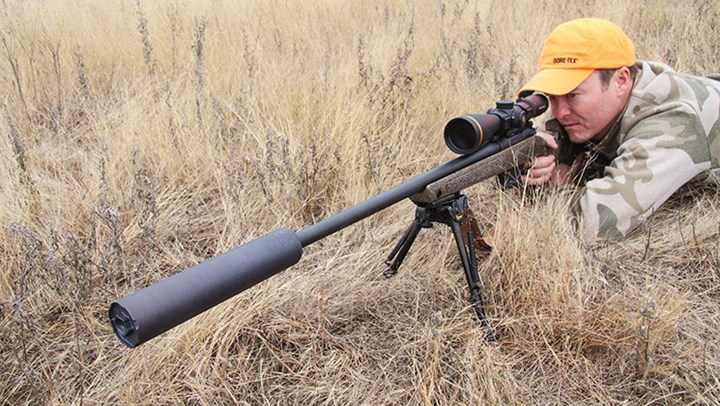
by Brian McCombie - Monday, May 10, 2021

Recently, I wrote an article for the NRA’s America’s First Freedom (A1F) website about a new attempt by some federal-level politicians to make suppressors illegal. The “Help Empower Americans to Respond” or HEAR Act would, if passed into law, ban the importation, sale, manufacturing, transfer and even the very possession of suppressors—despite that suppressors reduce hunters’ and shooters’ risk of hearing damage. Pitched under the guise of enhancing public safety, it was introduced by two New Jersey legislators: Rep. Bonnie Watson Coleman (D-12) in the House and Sen. Bob Menendez (D) in the Senate.
“Gun silencers are dangerous devices with one purpose and one purpose only—to muffle the sound of gunfire from unsuspecting victims,” said Menendez. “The sound of gunshots is what signals you to run, hide, take cover, call the police and help others save themselves; however, this is nearly impossible when a gun silencer is used.”
This is completely false on nearly every level, said Knox Williams, Executive Director of the American Suppressor Association (ASA), a shooting sports industry group dedicated to educating the public about the many positive uses of suppressors. As my A1F article and material on this NRA Hunters’ Leadership Forum (NRAHLF.org ) website regularly notes, suppressors are rarely used in crimes, they are already heavily regulated under the National Firearms Act, and of course they do not “silence” firearms. That’s Hollywood fiction right out of spy movies and mob flicks. As the NRA Institute for Legislative Action (NRA-ILA) explains in fighting to protect their use, suppressors simply protect one’s hearing, reduce recoil and muzzle report, and mitigate any noise complaints from neighboring properties. (To read the NRA HLF fact sheet on the benefits of suppressors, click here.)
In reality, suppressors reduce the muzzle blast of firearms below the 140-decibel (dB) threshold known to damage human hearing. Generally, a suppressor will reduce a gunshot by 20 to 35 dB. Yet suppressed firearms are still quite loud. According to ASA data, an average unsuppressed gunshot measures 165 dB; an unsuppressed rifle fired with a muzzle brake may measure 185 dB. Any sound experienced above 140 dB can pose instant risk of hearing damage. An average suppressed gunshot measures 130-140 dB. An ambulance siren measures 120 dB. At this level, a pain threshold is crossed at nine seconds.
And hunters, it turns out, are the group most likely to benefit from suppressor use. According to Dr. William W. Clark, Director of the Washington University School of Medicine Program in Audiology and Communication Sciences, “The most-serious threat to hearing comes from recreational hunting or target shooting.”
As Clark went on to explain, “This is in large part due to the fact many people choose not to use traditional hearing protection devices like earplugs and earmuffs because they want to be able to hear their surroundings. Multiple studies have found that between 70 to 80 percent of hunters never wear earplugs or earmuffs, and nearly half of all target shooters don’t consistently wear traditional hearing protection. Thus, it should come as no surprise that for every five years of hunting, hunters become 7 percent more likely to experience high-frequency hearing loss.
Currently, suppressers are legal in 42 states and Americans own an estimated 2 million of them. Since 2011, an additional 18 states have legalized the use of suppressors while hunting, bringing the total number of states where it's legal to practice suppressed hunting to 40. Vermont and Connecticut are the only two states where you can own a suppressor but can't use it in the field.
Darren Jones is the marketing director for AB Suppressor in New Century, Kan., and has used suppressors for nearly a decade. A dedicated hunter, Jones almost never goes afield without a “muffler” on his firearm.
“Despite the regulatory barriers to entry, suppressors have grown even more in popularity because of the benefits that they add to the shooting experience,” said Jones. “Although still loud by decibel standards, suppressors allow firearms to be enjoyed without causing significant hearing damage.”
Jones added, “In the field, hunters using suppressed firearms can communicate easily without wearing ear plugs or muffs. I’ve also used suppressed firearms when introducing new people to hunting. Suppressors not only reduce the loud blast, they cut back on a rifle or shotgun’s recoil, making the hunting experience even more enjoyable for novices.”
As Jones noted, suppressors are already greatly regulated. To purchase one, a person first has to find a Class III firearms dealer, fill out the proper forms (which include providing fingerprints and a photograph, plus informing local law enforcement of the purchase) then pay $200 for a federal tax stamp.
At this point, a federal background check is initiated. Once the purchaser has passed that background check, he or she must then wait for the Bureau of Alcohol, Tobacco Firearms and Explosives (ATF) to actually process the approval, and this can take up to a year.
Meanwhile, the person trying to buy the suppressor has paid for the suppressor and the tax stamp and likely will have to pay a transfer fee once the ATF has given the Class III dealer the go-ahead on the suppressor.
That’s a great deal of time and money we hunters have to invest just to protect our hearing and to make our shooting experiences safer all around. But our hearing is worth it.
Editor’s Note: For some trivia, anyone not familiar with the use of suppressors may be surprised to learn they have been in existence for more than 100 years. In fact, U.S. President and NRA Life member Teddy Roosevelt is said to have used one on his Winchester Model 94 at his Long Island home in New York to keep from disturbing neighbors while dispatching varmints. Reducing noise complaints from neighbors is yet another benefit of suppressors considering such complaints are often used as an excuse to close hunting and shooting ranges.
E-mail your comments/questions about this site to:
[email protected]
